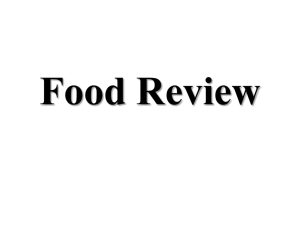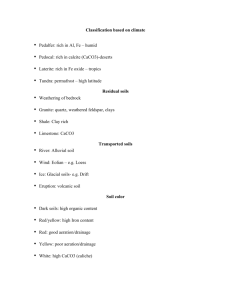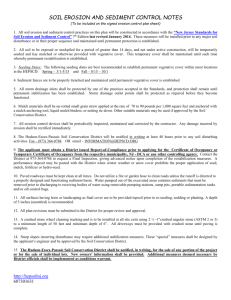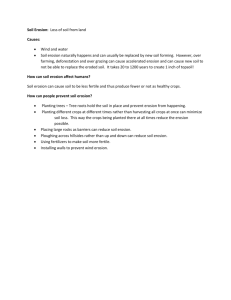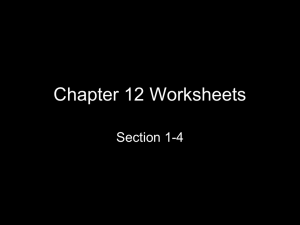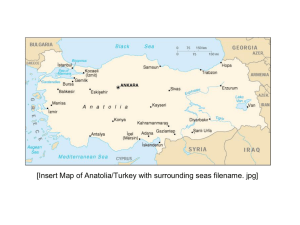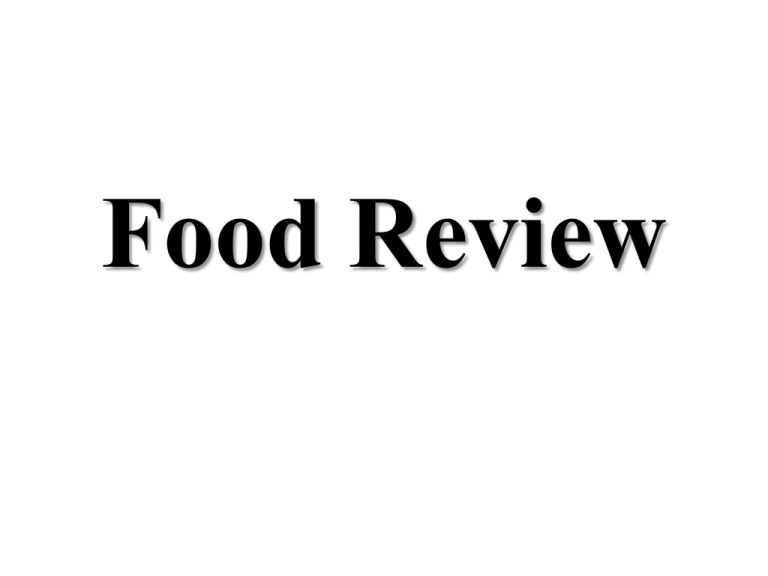
Food Review
Integrated pest management ____ than
pesticides.
A. is more expensive
B. is faster acting
C. requires more knowledge about
pest-crop
D. is less expensive
E. requires more fertilizer, irrigation,
plowing, and diesel fuel
The U. S. agency charged with slowing soil
degradation is the _______.
A. Soil Aggregation Service
B. Natural Resources Conservation Service
C. Agricultural Standards Agency
D. Conservation Integration Service
E. No U.S. agency, only private firms
funded by farmers.
Shelterbelts are to _______ as
terraces are to _______.
A. stratification; salinization
B. wind erosion; water erosion
C. salinization; stratification
D. water erosion; wind erosion
E. leaching; desertification
Raising _______ requires the
most land and water.
A. pigs
B. beef cattle
C. chickens
D. dairy cattle
E. goats
Monoculture _______.
A. describes the farming practice of
growing large stands of a single species
B. describes food that has not been
genetically modified
C. describes diets low in protein, such as
vegetarianism
D. farming is a food-growing practice that
uses no synthetic fertilizers or pesticides
E. farming is illegal in most countries
It is more energetically
efficient to eat _______.
A. herbivores
B. carnivores
C. chicken
D. primary producers
E. secondary consumers
Contour farming involves
a. converting
A. steep slope into a series of
terraces.
B. plowing at right angles to slopes.
C. building a series of small dams.
D. plowing straight down slope or
straight up slope.
The consequences of
overfertilization can include
A. very large fruits and vegetables
B. crops spreading rapidly into
nearby areas
C. large crop yields per acre
D. eutrophication in nearby waters
E. very fertile soils in future years
pH of the soil influences
_______.
A. the number of soil horizons
B. soil clumpiness
C. soil compaction
D. leaching
E. plant growth
Humus is _______.
A. one of the primary causes of desertification if
it is present in excess
B. composed of organic compounds and is
necessary for fertile soils and for holding soil
moisture
C. the artificial fertilizer applied to monocultures
D. a layer sometimes found in a soil horizon that
is created by eluviation; it causes serious
problems in agricultural fields
E. caused by agricultural runoff into waterways
or into the water table
The buildup of salts in soils as a
result of overirrigation is _______.
A. weathering
B. erosion
C. evaporation
D. leaching
E. salinization
Industrialization of farms _______.
A. rapidly deteriorated soils, requiring
continuous movement to new croplands
B. improved soils permanently, providing
more food from less space
C. had no impact on agriculture
D. is necessary today for all cultures
E. increased the ability to obtain more food
from the same area
The loss of more than 10%
productivity in arid areas due to
erosion, soil compaction, forest
removal, and an array of other factors
is called _______.
A. stratification
B. climatization
C. salinization
D. desertification
E. global change
Recombinant DNA _______.
A. is assembled in the lab from
mononucleotides
B. was part of the green revolution of the
1960s
C. describes pollination of one plant by
another of the same species
D. describes the merging of DNA from
unrelated organisms to create new
hybrids
E. describes pollination of one plant by
another of a different species
DDT was investigated by _____
between 1958 and 1962 and found to
be harmful to wildlife and humans.
A. G. Tyler Miller
B. Paul Hermann Müller
C. Lester Brown
D. Rachel Carson
E. Paul Hewitt
Livestock in the United States
produces 20 times more ____ than
is produced by the country's human
population.
A. water
B. methane
C. manure
D. carbon dioxide
E. carbon monoxide
Conservation tillage
A. increases labor costs.
B. increases erosion.
C. decreases erosion.
D. increases energy
consumption.
E. accelerates water loss from
the soil.
Which of the following types of
agriculture is most characteristic of
developed countries?
A. high-input
B. industrialized
C. traditional subsistence
D. traditional intensive
E. plantation
Commercially available
inorganic fertilizers
A. increase soil porosity.
B. increase soil water-holding
capacity.
C. raise the oxygen content of
soil.
D. contain all trace elements.
E. lack trace elements.
The ideal pesticide
A. would kill only the target pest.
B. would be of equal value to the
damage the pest would have caused.
C. would kill every plant it came into
contact with.
D. would be persistent.
E. would allow the development of
genetic resistance.
A pheromone is
A. a species-specific chemical sex
attractant.
B. a new form of chemical insecticide
waiting approval by FIFRA.
C. a safe, natural pesticide.
D. a strong herbicide.
E. a bloodstream chemical that
controls an organism's growth and
development.
Which of the following would be
used to kill weeds?
A. fungicides
B. rodenticides
C. nematocides
D. herbicides
E. insecticides
Since 1950, the majority of the
increase in food production is a
result of the ____ revolution.
A. red
B. green
C. blue
D. purple
E. yellow
Most soil erosion is caused by
A. earthquakes.
B. volcanoes.
C. wind.
D. moving water.
E. excess heat.
The term overnutrition refers to
people who
A. eat balanced meals.
B. eat less than the basic minimum
number of daily calories.
C. suffer from poor food quality.
D. eat too many calories each day.
E. eat too much protein.
The term undernutrition refers to
people who
A. eat balanced meals.
B. eat too much protein.
C. suffer from poor food quality.
D. eat too much.
E. eat less than the basic minimum
number of daily calories.
The term malnutrition refers to people
who
A. eat too much.
B. eat balanced meals.
C. eat less than the basic minimum
number of daily calories.
D. eat too much protein.
E. suffer from poor food quality.
Fish species cultivated in
aquaculture include all of the
following EXCEPT
A. tuna.
B. trout.
C. tilapia.
D. carp.
E. clams.
Insects are usually _______.
A. essential for successful
agriculture
B. harmful to agriculture
C. invasive species
D. keystone species
E. genetically modified species
Plants with showy flowers typically
_______.
A. are pollinated by animals
B. are killed by animals
C. are eaten by animals
D. decrease biodiversity in an area
E. are genetically modified by
animals

